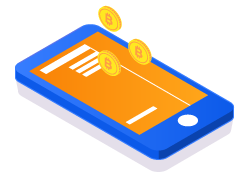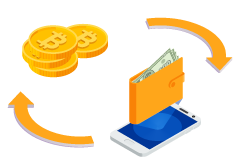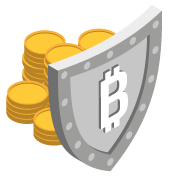
Bitcoin wallets are as confusing as the concept of cryptocurrencies for some users. It’s hard for some to picture how a virtual storage space works for virtual currencies without physical representation.
It can also be difficult to understand how the encryption works or how the cryptocurrencies are actually stored.
That said, what you need to understand first is that Bitcoin wallets, and crypto wallets in general, come in many different forms. Each offers unique benefits or drawbacks regarding convenience and/or security.
What’s really interesting is that everyone can make their own Bitcoin wallet. As you’ll soon find out, having a personal wallet, or even more than one, is the best move you can make. There are differences between the wallet that you access on an exchange and one you can have total control over.
Creating a Bitcoin Wallet App

Although not known as the most secure, Bitcoin wallet apps are very popular for convenience. If you don’t like the existing offering, you can always try to develop your own wallet app. Just know that it’s not easy without coding skills and an understanding of how blockchain technology works.
In essence, you have a few things to check off your list to ensure that you have a good working wallet:
- A sign-up and login feature
- A user-friendly profile page/dashboard for the users where they can check the balance
- Password/pin code security features
- Notifications for transactions, market prices, and so on
- Implement a QR scanner to simplify transactions
- Real-time information on exchange rates
- Optional – a trading service so that you can sell or buy Bitcoin from other people
Implementing security features will be the most difficult task. Enlisting third-party developers to do this may not be the best idea. Especially if you have some coding skills.
Decide if you want an Android or iPhone Bitcoin wallet. Obviously, you’ll need different technologies to create your wallet based on the OS it will run on. For example, Java and Node JS/Python is a solid combination for Android wallets.
For iOS wallets, you may use Swift for both frontend and backend development.
Never forget to implement a two-step authorization feature. Encourage users to use their phone numbers for receiving authentication codes.
Another feature that most users appreciate is a backup for your wallet. This can be done by generating a unique passphrase to recover the wallet. Or, you can set up a unique wallet restoration link that you can send to users via email.
Either way, this involves serious coding skills.
A Note on Public Libraries

Just like with anything else, it’s possible to create an app without making everything from scratch. There are various public libraries that you can use to cut down the workload.
For example, there are Chain-Java and Bitcoin SDK libraries. These already contain blockchain standard functionalities. New developers can use these libraries and speed up the app development thanks to all the implemented tools made available.
Blockchain.Info is a good resource for getting your full stack of APIs. This will allow you to quickly add Bitcoin wallet features and functionality. Features which also include handling of payments or simple transfers.
The Coinbase SDK library is also an interesting choice. It comes in a variety of programming languages so you will be able to create a multi-platform friendly Bitcoin wallet. On top of that, it offers support for other popular crypto coins such as Litecoin and Ethereum.
Crypto Wallets Are Not One and Done

If you take on the task of creating a Bitcoin wallet, you’re signing up for long-term involvement. One of the things that will require your attention the most is the security aspect.
You need to make constant security updates. This involves frequent app testing, checking user reviews, learning more about blockchain technology, and staying up to date on the newest malware attacks. Especially in the crypto exchange sphere.
Simply put, it’s not a one-man job. Especially once you reach a large number of users.
Different Bitcoin Wallet Classifications
Mobile or online Bitcoin wallets aren’t the only types of wallets available. Even though they may be the most popular and most used, there are other options for crypto users, investors, and merchants that want to accept crypto payments.
Cold Wallets
A cold wallet is one of the best types of crypto wallets. Cold wallets are not connected to the internet. They can be, but they don’t have to all the time. This makes for a more secure crypto asset storage.
Cold wallets are usually broken down into two categories – hardware wallets and paper wallets.
Both of those can generate and store valid private keys and public keys.
Hot Wallets
Hot wallets are connected wallets. They’re connected to the internet at all times. Users regard them as convenient as making transactions is very easy and involves fewer steps.
However, the lack of additional authentication and authorization steps also make hot wallets less secure. The fact that they’re always connected to the internet makes them more prone and vulnerable to attacks by hackers. And to various malware applications.
Online Wallets

An online wallet is more often than not hosted in the cloud. It’s a practical solution, seeing as it’s basically a version of the hot wallet. However, cloud wallets have been associated with scams too. More so than mobile Bitcoin wallets or exchange wallets.
In terms of convenience, they’re just as good as most hot wallets. But the security features are not impressive, to say the least.
Warm Wallets
The warm wallet is the designation for a cold wallet that can be connected to the internet. This means that it has a better combination of security and quality of life features.
A warm wallet typically allows smoother transactions than a cold wallet. At the same time, the fact that it can be disconnected from the internet means that your crypto assets would be more secure.
A distinct feature of most hot wallets is the fact that the generated private key won’t be revealed to the system. Hence third parties can’t steal that information.
Hardware Wallets

Most hardware wallets function similarly to USB devices. They can generate private keys, sign transactions, and can be unplugged from the internet.
Because these wallets stay offline most of the time, your assets are very secure. Hardware wallets also feature unique security features that make it near impossible for two-way information transfer.
This means that while the wallet can send information, it can’t really receive any on the same bandwidth. Therefore, it’s almost impossible to get malware on them or for someone to access them remotely for the purpose of stealing information.
When connected, they share some of the same features of hot wallets and allow users to make transactions quickly. Although safe, hardware wallets don’t come free and are usually expensive.
Paper Wallets

Paper wallets are very interesting. They’re essentially pieces of paper that store all the information needed to store and trade Bitcoin. As well as other cryptocurrencies.
As you know, Bitcoin has no physical representation. It’s a virtual currency. Therefore, a wallet only needs to contain the specific private and public keys, as well as the address. This information allows you to make your desired transactions.
Typically, they are considered very safe. However, they can also be lost, stolen, or misread at times. Therefore it’s a good idea to have more than one and keep your wallets secure in more than one place.
Anyone can make their own paper wallet. Or, they can use various Bitcoin paper wallet online generators and print a unique wallet.
How to Make a Paper Wallet

Making your own paper wallet or “brain wallet” can be very difficult without using a generator. You need a thorough understanding of blockchain technology. That doesn’t mean you can’t use a generator and still print your paper wallet safely.
- Download a popular paper wallet generator.
- Run a malware check on your system.
- Unplug your device and printer from the internet.
- Generate random strings of characters in the given text boxes.
- Make sure that you reach 100% on the randomness factor.
- This will generate a unique wallet address and keys.
- Choose your preferred artwork.
- Add additional encryption methods for creating stronger passphrases.
- Print your wallet.
- Clear the cache, downloaded files, and run a new malware check on your system.
- Clear the cache on your printer too.
- Delete the generator and any additional downloaded files that relate to it.
You can now connect your devices back to the internet. Access your exchange wallet and find the Send or Transfer button on your dashboard.
Type in the address as it appears on your paper wallet. Even though your wallet isn’t connected to the internet, the created address is valid and will be recognized within the blockchain.
Whenever you want to move Bitcoin, you can do so by using the information on your wallet. If you want to convert your crypto into fiat currency, simply supply crypto to your exchange wallet. Do that from the address listed on the paper wallet.
Use the keys listed on the wallet for authentication purposes.
Should You Make Your Own Bitcoin Wallet App?

Probably not if you’re simply a user. But, it’s a great idea if you’re looking to monetize your app development skills. If you’re serious about investing in Bitcoin and you plan on holding on to your crypto long-term, then a paper wallet may just suit you best.
Will You Still Need an Exchange Wallet?

Yes. If you want to conduct your first crypto transactions, you will need to register an account on an exchange. Unless somehow you get gifted some crypto from someone, or get your first salary in crypto, you will have to buy your first virtual coins.
Exchange wallets allow you to load them with fiat currency that you can then convert into the crypto coins of your choice. Bitcoin being the popular choice, even if you can only afford a fraction of a coin.
This is something that you can’t do with a hardware wallet, i.e. supplying it with fiat money from a credit card or bank account for exchanging to crypto.
But just because you’re periodically investing in crypto, doesn’t mean you have to hold your funds in the wallet provided by the exchange.
Although the process of constantly transferring assets back and forth can be tedious, it’s the safest approach. The exchange wallet will always be more vulnerable than your offline storage solution.
How to Transfer Crypto to and from Your Exchange Wallet

The process should be fairly similar regardless of the exchange you’re on. Just note that there may be transaction fees involved.
All crypto exchanges offer a virtual wallet. This means that you’ll have a UI where you can check your balance and all the assets you own.
While the UIs are different, all should have a Transfer or Send button. Once you click it, or tap it, a transfer form should pop up. In the field where it asks for an address, you should type in the address generated by your personal wallet (hardware, paper, mobile, etc.).
Also, put in the required key and authenticate the transaction based on the layers of security used by the exchange.
Note that transferring crypto from an exchange to a third-party wallet may not be instant. In some cases, you may have to wait more than 30 minutes for the transaction to go through. It’s not as fast as buying crypto from the exchange using fiat currency. This action typically gets handled within seconds.
Safety First

Securing your crypto assets has never been more important. Although security features are ever-improving, so is the malware and hacking tools used to steal cryptocurrency from exchanges or unassuming crypto users.
Finding the right Bitcoin wallet solution is important if you don’t want to lose your investment. The first step involves finding a reputable exchange that can keep your crypto assets secure at least in the short term.
Next, you’ll have to decide as to where you want to store your assets in the long term. Cold wallets are the best for long-term storage. Which one you’ll end up using should be up to you. However, nothing beats a USB hardware wallet or a paper wallet that’s completely unhackable.